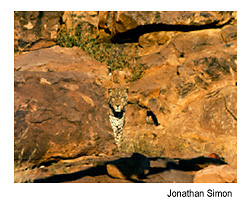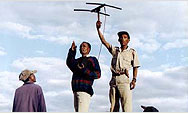 |
Biodiversity
Biodiversity is the variety and variability of life on Earth. This includes all of the plants and animals that live and grow on the Earth, all of the habitats that they call home, and all of the natural processes of which they are a part. The earth supports an incredible array of biodiversity—from Thailand’s tiny bumblebee bat to the ocean’s great blue whale—with plants and animals of all shapes and sizes in between.
 |
Camouflaged by its rocky surroundings, this
leopard in Namibia is among the thousands of
animals worldwide that are threatened with
extinction. |
This fantastic variety of life is found in diverse habitats ranging from the hottest desert to tropical rainforests to the arctic tundra. Biodiversity is essential to every aspect of the way that humans live around the world. Plants and animals provide people with food and medicine, trees play an important role in absorbing greenhouse gases and cleaning the air we breathe, and rivers and watersheds provide the clean water that we drink.
Unfortunately, the earth’s biodiversity is disappearing, with an estimated 1,000 species per year becoming extinct. Conserving biodiversity is especially crucial in developing countries where people’s livelihoods are directly dependent on natural resources such as forests, fisheries and wildlife.
In recognition of the importance of biodiversity, USAID has made biodiversity conservation a key goal under its program to protect the environment. USAID is supporting conservation activities in more than 50 countries, seeking to maintain the variety of species and the habitats in which they occur.
USAID is working with communities, non-governmental organizations, and governments to develop environmental policies and management practices that conserve biodiversity and, at the same time, sustain local livelihoods. This can involve empowering communities to become stronger actors in the management of resources. USAID also invests in building the capacity of foreign governments, non-governmental organizations, and communities to better manage protected areas. In addition, USAID is promoting enterprise-based conservation initiatives (such as eco-tourism), which provide economic benefits from the preservation of biological resources. To complement these activities, USAID fosters greater public awareness of conservation issues by supporting the development of outreach and environmental education programs.
Why Conserve Biodiversity?
Biodiversity is the very foundation for all the Earth's essential goods and services. The air we breathe, water we drink, and the food we eat all depend on the Earth's rich biodiversity. USAID’s biodiversity conservation activities not only protect the environment in developing countries but also have significant economic value to the United States.
Plants and animals provide people with food and medicine. Forty percent of all prescriptions written today are composed from the natural compounds found in different species. An estimated 80,000 edible plants are found in the world, and one in every three mouthfuls of the food you swallow is prepared from plants pollinated by wild insects and animals. The extinction of each additional species results in the irreversible loss of unique genetic materials, each of which has potential for development of medicines and foods and associated enterprises that create jobs.
While plants and animals keep you well fed and healthy, trees play an important role in absorbing greenhouse gases. Through photosynthesis, trees absorb and store atmospheric carbon, helping to combat global warming and purifying the air we breathe. Forests also control soil erosion and purify water.
As natural systems breakdown, people around the world are forced to find alternative and often more costly ways to maintain adequate supplies of clean water or to deal with increasingly polluted air. The net economic benefits of biodiversity are estimated to be at least $3 trillion per year, or 11 percent of the annual world economic output.
Back to Top ^
|


